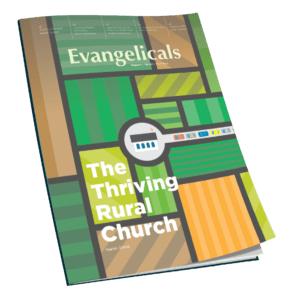 The Thriving Rural Church
The Thriving Rural Church
The following four articles are courtesy of the National Association of Evangelicals’
Fall 2017 Evangelicals Magazine
The Thriving Rural Church
Rural culture is historically very different from urban and suburban culture. Most rural people were farmers, and their livelihoods were constantly subject to factors beyond their control — the weather, crop and livestock diseases, global marketing patterns, etc. Living with this unpredictability and perpetual uncertainty remains a significant pressure in the lives of rural people. The driving dynamics of uncertainty and isolation directly affect how rural people think, relate and make decisions. Read the full article.
 Martin Giese, president of Oak Hills Christian College in Bemidji, Minnesota, and co-author of “Leading Through Change: Shepherding the Town and Country Church in a New Era.” He pastored two rural churches over a period of 40 years.
Martin Giese, president of Oak Hills Christian College in Bemidji, Minnesota, and co-author of “Leading Through Change: Shepherding the Town and Country Church in a New Era.” He pastored two rural churches over a period of 40 years.
Register here for the Grow! 2018 Leadership Conference for the rural and small town church.
America’s 15%
Rural is only 15 percent of America if you measure by population in rural counties — 46.2 million out of 308 million population. But, 46 million is 8 million more than the population of California and nearly twice the population of Texas. In other words, there are a lot of people living in rural America. The Census Bureau has a curious way of deciding who is rural and who is not. Read the full article.
 Leith Anderson has been president of the National Association of Evangelicals since 2006, and was the senior pastor of Wooddale Church in Eden Prairie, Minnesota, for 35 years before retiring in 2011.
Leith Anderson has been president of the National Association of Evangelicals since 2006, and was the senior pastor of Wooddale Church in Eden Prairie, Minnesota, for 35 years before retiring in 2011.
Register here for the Grow! 2018 Leadership Conference for the rural and small town church.
The Rural Reality of Poverty
Current poverty rates in rural America exceed the poverty rates in urban communities, and there are significantly less social services available to address these needs, according to the National Advisory Committee on Rural Health and Human Services. Persistent poverty counties have poverty rates of 20 percent or higher, and 88 percent of persistent poverty counties are rural. The U.S. Department of Agriculture notes that one in four children in rural America lives in poverty. Read the full article.
 Steve Donaldson is senior director of Rural Compassion for Convoy of Hope. He is also a presenter at the upcoming 2018 Grow! Conference.
Steve Donaldson is senior director of Rural Compassion for Convoy of Hope. He is also a presenter at the upcoming 2018 Grow! Conference.
Register here for the Grow! 2018 Leadership Conference for the rural and small town church.
On Pastoring the Rural
Rural churches also need to think regionally. A pastor friend in Iowa told me, “People here will drive two hours to play, one hour to work, and 30 minutes to Menards’ [a hardware chain]. We assume they’ll drive 30 minutes to church.” Focusing on a county as opposed to a town is a good start.
Another thing is mission. Many small town churches have a wonderful legacy. But we can confuse strategy with mission… Read the full article.
 Paul Jorgensen has served as lead teaching pastor at Cornerstone Church in Litchfield, Minnesota, for the past seven years.
Paul Jorgensen has served as lead teaching pastor at Cornerstone Church in Litchfield, Minnesota, for the past seven years.
Register here for the Grow! 2018 Leadership Conference for the rural and small town church.
Join us for the second annual Grow! 2018 Leadership Conference
Serving rural and small town church leaders
Saturday, March 3, 2018 from 8:30am – 4pm
Willmar Assembly of God Church
Register here
God has strategically placed churches in rural areas and small towns in order to impact our culture for the kingdom of God.
The Grow! Conference will provide pastors and board members information on how to minister effectively, encourage them to see their unique role in God’s plan, and help them take steps to impact their world for all of eternity.
